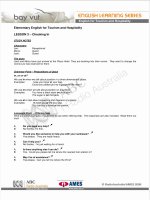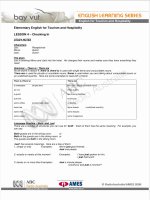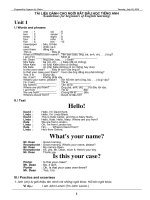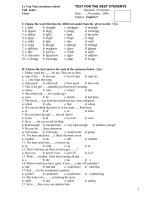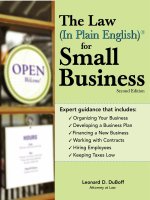English for auditing compatibility mode
Bạn đang xem bản rút gọn của tài liệu. Xem và tải ngay bản đầy đủ của tài liệu tại đây (1.96 MB, 100 trang )
ENGLISH FOR AUDITING
1
Outlines
3.1. Basic Auditing (Các vấn đề chung về kiểm toán)
3.2. Techniques in Collecting Audit Evidence (Các kỹ
thuật thu thập bằng chứng kiểm toán )
3.3. Types of Audit Tests (Thử nghiệm kiểm toán)
3.4. Internal Control (Kiểm soát nội bộ)
3.5. Audit of Items in Financial Statements and Business
Cycles (Kiểm toán các khoản mục trên báo cáo tài chính và
các chu trình kinh doanh)
2
3.1.
Basic Auditing
3
3.1.1. Nature of Auditing
Auditing is the accumulation and evaluation
of evidence about information to determine
and report on the degree of correspondence
between the information and established criteria.
Auditing should be done by a competent,
independent person.
4
Information and Established
Criteria
To do an audit, there must be information in a
verifiable form and some standards (criteria)
by which the auditor can evaluate the information.
FASB
Criteria
IASB
5
Accumulating Evidence and
Evaluating Evidence
Evidence is any information used by the auditor
to determine whether the information being
audited is stated in accordance with the
established criteria.
Transaction
data
Client
Testimony
Written and
electronic
Communications
with outsiders
Observations
6
Competent, Independent
Person
Judgment and
Experience
Competence
Independence
Evaluation of
Evidence
Proper
Conclusion
7
3.1.2.
Types of Audits and
Types of Auditors
8
Types of Audits
1
Operational Audit
2
Compliance Audit
3
Audit of Financial Statement
9
Operational Audit
Example
Evaluate computerized payroll system
for efficiency and effectiveness
Information
Number of records processed, costs of
the department, and number of errors
Established
Criteria
Company standards for efficiency and
effectiveness in payroll department
Available
Evidence
Error reports, payroll records, and
payroll processing costs
10
Compliance Audit
Example
Determine whether bank requirements
for loan continuation have been met
Information
Company records
Established
Criteria
Loan agreement provisions
Available
Evidence
Financial statements and
calculations by the auditor
11
Audit of Financial Statements
Example
Annual audit of Boeing’s financial
statements
Information
Boeing's financial statements
Established
Criteria
Generally accepted accounting
principles
Available
Evidence
Documents, records, and outside
sources of evidence
12
Types of Auditors
1
Independent auditors/
Certified public accounting firms
2
Governmental accountability office auditors
3
Internal auditors
13
Three Requirements for
Becoming a CPA
Educational requirement
Uniform CPA examination requirement
Experience requirement
14
3.1.3. Fundamental Concepts
in Auditing
Learning objectives
Fraud and Error
Materiality and Audit risk
Audit Evidence
15
Fraud and Error
A Student took materials (text books or mini photocopies) in
examination room. (Rule: Close-book exam)
What is fraud and error?
16
What is Fraud?
Fraud is an intentional act by one or more individuals among
management, those charged with governance, employees, or third
parties, involving the use of deception to obtain an unjust or
illegal advantage.
Although fraud is a broad legal concept, the auditor is concerned
with fraud that causes a material misstatement in the financial
statements.
17
Types of Fraud
Misappropriation of assets
Fraudulent Financial Reporting
18
Misappropriation of assets (“employee fraud”) involves theft of an
entity’s asset.
Examples include:
Embezzling receipts
Stealing physical assets or intellectual property
Assets are used wrong purposes
….
19
Fraudulent Financial Reporting (“management fraud”)
Misrepresentation in, or intentional omission from, the financial
statements of events, transactions, or other significant information
Manipulation, falsification or alteration of records or documents
from which financial statements are prepared
Intentional misapplication of accounting principles relating to
amounts, classification, manner of presentation, or disclosures.
20
What is Error?
Unintentional mistakes in financial information such as:
Errors of commission: mathematical or clerical mistakes
in the recording and accounting data;
Errors of omission: transactions, events is left out of an
accounting statement by mistake.
Errors of principle: misapplication or misunderstanding of
accounting policies unintentionally. Ex: wrong allocation
between different accounts, wrong valuation of assets,…
21
Study break
An CPA has the responsibility to design the audit to provide
reasonable assurance of detecting errors and fraud that may have
a material effect on FS. Which of the following, if material,
would be a fraud as defined in auditing standard:
1, Misappropriation of an assets
2, Mistake in calculation of asset’s value
3, Mistake in application of accounting principles
4, Duplication of recording accounting transaction
unintentionally
22
Materiality
Materiality is the magnitude of an omission or
misstatement of accounting information that, in the light of
surrounding circumstances, make it probable that the judgment
of reasonable person relying on the information would have
been changed or influenced by the omission or misstatement.
23
Assessment of Materiality
Materiality is a relative rather than absolute concept
Materiality includes both quantitative and qualitative
consideration (size and nature of the misstatement)
24
Quantitative materiality level
No official guidelines within auditing standards
Bases for evaluating Materiality
5-10% of Net Income before Taxes
½-1% of Total Assets
½-1% of Total Revenue
1- 2% of Equity
Auditor add up all individually immaterial misstatements in
order to detect material misstatement in aggregate.
25
